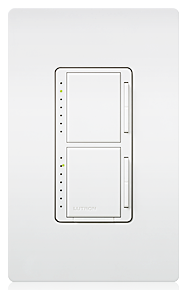Dim and Dimmer
by Eric Strandberg LC
Dimmers today come in many styles and control many different types of loads. A typical building today may have a combination of line voltage and low voltage incandescent, fluorescent and even high intensity discharge loads. Proper matching of control system types to the load is very important. Not all wall box mounted dimmers work properly with all types of loads. Incandescent dimmer types include: standard line voltage (600W, 120V); high wattage (1000W -2000W); low voltage magnetic (inductive or volt/amp); and low voltage electronic (solid state). Most of these require different types of dimming devices, though the covers and controllers can usually be made to match for a uniform look on the wall. Much higher wattages can be handled with remote dimmers. In this case, the dimmer is not in the box on the wall, but in a closet or other location and the wall box contains only the dimmer controller.
 New dimming systems offer convenience and flexibility. The main feature of newer dimmers is the ability to offer "presets". This allows the user to set the light level to where they want it and then use a single control to turn the light to the pre-set level. This is a real convenience, allowing the creation of different moods, or scenes at the touch of a button. It also saves wear and tear on the dimmer. This preset concept can get quite elaborate, with master controllers operating multiple remote switches in more than one room. This allows for the creation of "scenes" for purposes ranging from entertainment to security. Several companies have products that allow for control of the entire building from a few locations. These products generally offer local override control from any room or zone. Most manufacturers offer 3-way controls (i.e., two devices that control one load or zone) but not all allow dimming at both locations.
New dimming systems offer convenience and flexibility. The main feature of newer dimmers is the ability to offer "presets". This allows the user to set the light level to where they want it and then use a single control to turn the light to the pre-set level. This is a real convenience, allowing the creation of different moods, or scenes at the touch of a button. It also saves wear and tear on the dimmer. This preset concept can get quite elaborate, with master controllers operating multiple remote switches in more than one room. This allows for the creation of "scenes" for purposes ranging from entertainment to security. Several companies have products that allow for control of the entire building from a few locations. These products generally offer local override control from any room or zone. Most manufacturers offer 3-way controls (i.e., two devices that control one load or zone) but not all allow dimming at both locations.
Incandescent dimming influences maintenance costs. Most of the better dimmers have a "soft start" feature that ramps up power to the lamp over a period of a few milliseconds, instead of closing the circuit to the filament instantly. This feature lengthens lamp life. Some of the more sophisticated systems have fade on and off times that can last from a few seconds to a few minutes. For incandescent loads, this prevents a shock to the filament and prolongs lamp life. Also, dimming an incandescent lamp by 10% will more than double the lamp life. A common misunderstanding is that dimming saves power. While some energy is saved its not as much as you may think. For example, if you dim an incandescent lamp to 50% you are still using about 75% of the power. Dimming fluorescent lamps does not extend lamp life.
Fluorescent dimming requires special planning. Dimming of fluorescent loads has been possible for decades for full-size (tubular) lamps, but only recently for compact fluorescent lamps. The cost of fluorescent dimming has come down considerably in recent years, making it a viable option for many applications. In all cases, you need a dimmable ballast in the fixtures and usually a dimmer that is designed to control fluorescent loads. If you have an existing fixture that you want to dim there can be yet another level of complexity. Many dimmable ballasts need a control wire from the dimmer to the ballast. There are some ballasts that that can operate with 2 wires (which is typical of many existing buildings), but check before you buy. For new construction it is usually not a problem to install an extra wire during construction but it does need to be planned for. There are also some screw-in CFLs that can be dimmed with standard dimmers and these will be clearly marked as such. -END-
